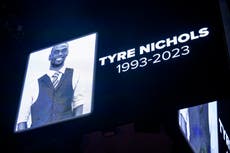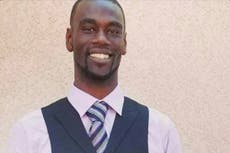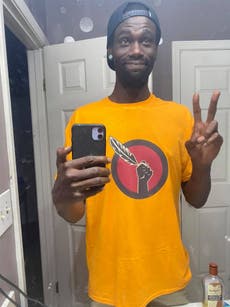Tyre Nichols’ death shows us the police are not always telling the whole truth
Police are partisan actors just like everyone else in power. It’s vital to take their claims with a grain of salt.

Your support helps us to tell the story
From reproductive rights to climate change to Big Tech, The Independent is on the ground when the story is developing. Whether it's investigating the financials of Elon Musk's pro-Trump PAC or producing our latest documentary, 'The A Word', which shines a light on the American women fighting for reproductive rights, we know how important it is to parse out the facts from the messaging.
At such a critical moment in US history, we need reporters on the ground. Your donation allows us to keep sending journalists to speak to both sides of the story.
The Independent is trusted by Americans across the entire political spectrum. And unlike many other quality news outlets, we choose not to lock Americans out of our reporting and analysis with paywalls. We believe quality journalism should be available to everyone, paid for by those who can afford it.
Your support makes all the difference.As the nation turns its attention to the death of Tyre Nichols, there’s something you need to know. In cases like these, police don’t always tell the full truth. Sometimes they seek to distract from it. Other times they flat-out lie.
This is well known to victims of police violence, civil rights organisers, and those, like me, who spend their days covering policing. But it’s an important thing to remember after the Friday release of law enforcement video of Nichols’s 7 January arrest, perhaps the most explosive instance of police misconduct since George Floyd. Here’s what I’ve learned covering the cops.
The distortions or omissions usually occur right in the initial, crucial moments as news of another police killing breaks.
On 8 January, a day after Nichols’ arrest, Memphis police said they stopped the 29-year-old for “reckless driving” and described in vague language a “confrontation” that occurred between him and officers.
Three weeks later, once the death of Tyre Nichols and photos of his badly mangled face became national news, Memphis Police Chief Cerelyn Davis said after a review of police evidence she couldn’t find any probable cause for the stop that left Nichols, as his family put it, beaten like a “human piñata.”
“We’ve taken a pretty extensive look to determine, you know, what that probable cause was, and we have not been able to substantiate that,” she said today. “It doesn’t mean that something didn’t happen, but there’s no proof.”
A similar, highly skewed initial report occurred in the 2020 death of George Floyd. Here’s what Minneapolis police initially wrote about the incident.
He was ordered to step from his car. After he got out, he physically resisted officers. Officers were able to get the suspect into handcuffs and noted he appeared to be suffering medical distress. Officers called for an ambulance.
This is a surreally inaccurate way to describe what actually happened: four officers kneeling on top of the man as he insisted over and over again for minutes he was being suffocated, before going unconscious. Police were the medical emergency here. Had teenager Darnella Frazier not recorded the incident with her cell phone, we may never have known the full truth.
In Chicago, “16 shots and a cover-up” became a popular chant among activists, after investigations revealed extensive police efforts to mislead the public and suppress evidence of the 2014 shooting of 17-year-old Laquan McDonald.
Other forms of spin occur once protests break out. Those who have seen it have warned the Tyre Nichols video captures a “heinous,” Rodney King-level of police brutality. It’s very likely large-scale civil rights demonstrations will fill the streets once again.
And when such situations do occur, officials have a way of describing the unrest as an infusion of chaos from outside agitators, rather than a homegrown response to real instances of police violence.
Just look at Atlanta, where officials have made pains to highlight how five of the six people arrested during large demonstrations last weekend in police protests were from out of state.
Maybe so, but the reason they came from out of state was to rally against the shooting of activist Manuel “Tortuguita” Esteban Paez Terán, who was shot by police while in the middle of protesting a $90m police training facility being built over the strenuous objections of community members.
If some out-of-state residents are arrested in Memphis tonight and hauled before the cameras, judge them on their personal conduct, of course, but remember why they turned out in the first place. In a city with a Black police chief, even though a group of five Black officers arrested Nichols, Black people are still 1.5 times more likely to be shot by police than white people, according to data from Mapping Police Violence.
And as long as we’re correcting misunderstandings that benefit the police, here’s another key one: the trope of Black Lives Matter gone too far and the hobbled municipal police department.
If anything catches on fire during a protest tonight, it’s likely conservative media and Republican politicians will claim something like, see, this is what happens when we defund the police. The real violence is coming from Black and brown racial justice activists, not the police.
A reality check: police budgets are still almost universally growing across the country. After a decade of Black Lives Matter activism, police killings are at a decade-long high.
During the pandemic, many departments even used millions in additional federal Covid aid to further arm themselves with military weapons, The Marshall Project has reported.
As the Tyre Nichols scandal continues to widen, it’s vital to remember not everything police say is an unimpeachable fact. What is certain, however, is that America’s onslaught of police violence hasn’t slowed down in the slightest. Figuring out how to move forward requires a clear understanding of what is wrong in the first place. We must keep our eyes open.


